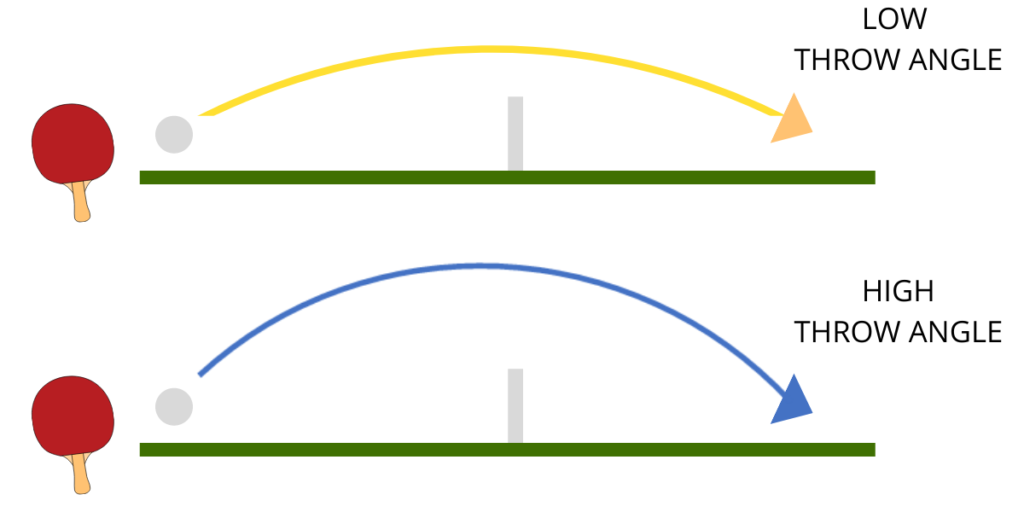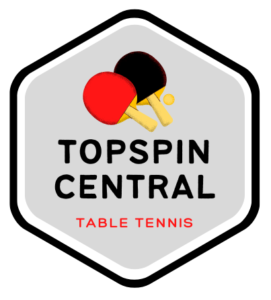Choosing the right table tennis rubber for your style can be a difficult process. The term “throw angle” can be fairly confusing, so in this article I’ll be explaining what it means and how it can affect your game by comparing rubbers with low and high throw angles.
What is the “Throw Angle”?
The throw angle refers to the angle at which the ball flies off the paddle after the stroke. A high throw angle means that the ball will be lifted higher into the air and the trajectory will have a greater arc. A low throw angle means the ball will travel flatter.

The throw angle of a table tennis rubber is often related to how spin or speed orientated the rubber is. Some players refer to this as the “spin to speed ratio”.
- High throw angle rubbers typically have a higher spin to speed ratio, which means they focus on generating spin causing the ball to loop over the net more easily.
- Low throw angle rubbers generally have a high speed to spin ratio. This means they have a flatter trajectory as they do not loop as much.
The throw angle is dictated by many physical characteristics of the rubber including the hardness, thickness and tackiness.
- Softer rubber = higher throw angle
- Tackier rubber = higher throw angle
- Thicker rubber = higher throw angle
Inverted rubbers tend to have a higher throw angle compared to pimples-out rubbers. Anti-spin rubbers typically have the lowest throw angles.
Throw angles can be loosely categorised as follows:
- Low throw angle = <40 degrees
- Moderate throw angle = 40-44 degrees
- High throw angle = >45 degrees
Low vs High Throw Angles
Like with most characteristics of table tennis rubber, there isn’t necessarily a “best” throw angle, because different rubbers suit different players. It really depends on what your style is, and it’s best to experiment if you’ve only ever used one type of rubber to see what really suits you.
High throw angles make it easier for the ball to go over the net and make it easier to deal with the opponents shot and are able to lift backspin over the net easily. However, lower throw angles are harder for the opponent to return but require more effort to get the ball to go over the net.
Players who have a more “closed” racket will generally suit high throw angle rubbers because it will mean the ball will still go over the net. Players who have a more open position can use either high or low throw angle rubbers, but will need to adjust their technique accordingly.
In general, rubbers with a lower throw angle are more effective for flat-hitting and blocking. On the other hand, rubbers with a high throw angle are more suitable for looping.
| Low Throw Angle | High Throw Angle |
| Ball has a flatter trajectory | Ball is lifted higher |
| Small margin of error to get the ball over the net | Easier to get the ball over the net |
| Higher speed to spin ratio | Higher spin to speed ratio |
| Harder to counter | More forgiving but easier to return |
| Suits flat-hitting and blocking | Suits looping |
High Throw Angle Rubbers
- Andro Plasma 470
- Butterfly Dignics 09c
- Butterfly Tenergy 05
- DHS Hurricane 3
- Tibhar Grip-S Europe
Andro Plasma 470
Andro Plasma is a high speed and spin non-tacky rubber. It is medium-soft and has a very high throw angle making it great for looping. It can be a bit hard to control and generally suits more advanced, attacking players.
Butterfly Dignics 09c
Butterfly Dignics 09c has a very high throw angle and offers a lot of spin making it great for offensive players. It is a reasonably tacky rubber so feels more similar to a Chinese-style rubber than a Japanese/ Euro style tensor rubber.
Butterfly Tenergy 05
Tenergy 05 is one of the most popular table tennis rubbers on the market. It’s extremely high throw angle makes it perfect for looping but is also offers plenty of speed due to its harder sponge. It’s a pretty expensive rubber but is very durable.
DHS Hurricane 3
DHS Hurricane 3 is a Chinese-style rubber with a tacky topsheet which gives it a high throw angle. It requires the player to put more effort into the stroke, but in turn it offers tonnes of spin. It suits experienced attacking players and is not recommended for beginners.
Tibhar Grip-S Europe
Tibhar Grip-S Europe has a pretty tacky topsheet for a Euro-style rubber which gives it a higher throw angle that you’d expect. It’s also very reasonably priced compared to other brands such as Butterfly, making it a good option if you’re looking to try out a rubber with a higher throw angle.
Low Throw Angle Rubbers
- Butterfly Super Anti
- Stiga Mendo MP
- Yasaka V Stage
- Tibhar Super 40 Defense
- Butterfly Wakaba
Butterfly Super Anti
Butterfly Super Anti has an anti-spin topsheet which has very low friction and produces barely any spin. It has a very low throw angle and is used for defensive play and excels at serve returns. It’s best used for flat-hitting, blocking and chopping.
Stiga Mendo MP
Stiga Mendo MP is a high-speed and low-spin inverted rubber with a lower throw angle. It has a topsheet with very low friction and a medium hardness sponge. This rubber is often selected for blocking and shots feel very predictable.
Yasaka V Stage
Yasaka V Stage is a good inverted rubber for all-round style players looking for a low throw angle. It has a slightly tacky topsheet and medium sponge hardness and feels fairly balanced in terms of spin, speed and control.
Tibhar Super 40 Defense
Tibhar Super 40 Defense is an inverted rubber designed for, you guessed it, defensive-style players. It is good for blocking and flat-hitting but not great for looping given its low throw angle. It feels precise and easy to control.
Butterfly Wakaba
Butterfly Wakaba has a very low throw angle due to its super low-friction topsheet. It’s easy to control which makes it great for beginners. However, more advanced players will find it much too slow and not “spinny” enough to be competitive.
Here are some more articles you might find useful:
